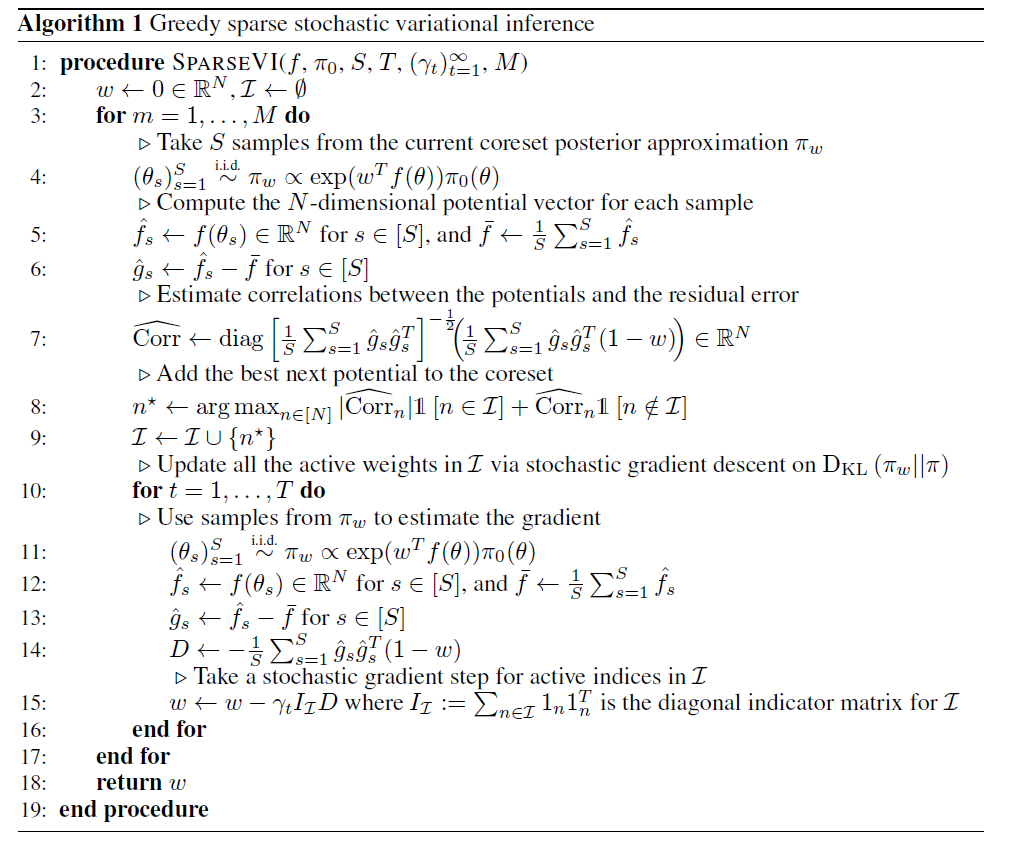Sparse Variational Inference : Bayesian Coresets from Scrath (NeurIPS 2019)
Abstract
Recent work on Bayesian coresets :
- compressing the data, before inference algorithm!
- goal : both (1) scalability & (2) guaranteees on posterior approximation error
Proposition :
- formulate coreset construction as “sparsity-constrained VI within an exponential family”
1. Introduction
Bayesian Inference is typically intractable : use MCMC or VI
Both methods were created on per-model basis.
But developments in automated tools have made it accessible to practitioners
-
ex) automatic differentiation, black-box gradient estimates, Hamiltonian transition kernels
-
but that’s not enough! should be computationally scalable!
Bayesian Coreset ( = core of a dataset )
- alternative approach
- (assumption) large datasets = contain redundant data
- computationally inexpensive & simple
Proposition :
provide a new formulation of coreset construction as exponential family VI with sparsity constraint
2. Background
Pdf : \(\pi(\theta)\)
- decompose into \(N\) potentials : \(\left(f_{n}(\theta)\right)_{n=1}^{N}\)
- base density : \(\pi_{0}(\theta)\)
Decomposition : \(\pi(\theta):=\frac{1}{Z} \exp \left(\sum_{n=1}^{N} f_{n}(\theta)\right) \pi_{0}(\theta)\)
Often intractable to compute expectations under \(\pi\) exactly…
To reduce the cost of MCMC… instead run it on small, weighted subset of data = “Bayesian Coreset”
WEIGHT : (Sparse vector) \(w \in \mathbb{R}_{>0}^{N}\) ( only \(M \ll N\) are nonzero )
Approximate full log-density, with \(w\)-reweighted sum
-
\(\pi_{w}(\theta):=\frac{1}{Z(w)} \exp \left(\sum_{n=1}^{N} w_{n} f_{n}(\theta)\right) \pi_{0}(\theta)\).,
where only \(M \ll N,\) are nonzero ( \(\mid \mid w \mid \mid _{0}:=\sum_{n=1}^{N} \mathbb{1}\left[w_{n}>0\right] \leq M\) )
-
\(\pi_{1}=\pi\) : full density
-
If \(M \ll N,\) evaluating a function proportional to \(\pi_{w}\) is much less expensive than original \(\pi\)
-
Goal : find a set of weights \(w\), that
- 1) makes \(\pi_w\) as close as \(\pi\) ( for accuracy )
- 2) maintain sparsity ( for speed )
into Sparse Regression Problem :
-
\(\begin{array}{l} w^{\star}=\underset{w \in \mathbb{R}^{N}}{\arg \min } \mathbb{E}_{\hat{\pi}}\left[\left(\sum_{n=1}^{N} g_{n}-\sum_{n=1}^{N} w_{n} g_{n}\right)^{2}\right] \text { s.t. } w \geq 0, \mid \mid w \mid \mid _{0} \leq M \end{array}\).
where \(g_{n}:=\left(f_{n}-\mathbb{E}_{\hat{\pi}}\left[f_{n}\right]\right)\)
using MC approximation :
- \(w^{\star}=\underset{w \in \mathbb{R}^{N}}{\arg \min } \mid \mid \sum_{n=1}^{N} \hat{g}_{n}-\sum_{n=1}^{N} w_{n} \hat{g}_{n} \mid \mid _{2}^{2} \text { s.t. } w \geq 0, \mid \mid w \mid \mid _{0} \leq M\).
- where
- \(\left(\theta_{s}\right)_{s=1}^{S} \stackrel{\text { i.i.d. }}{\sim} \hat{\pi}\).
- \(\hat{g}_{n}=\sqrt{S}^{-1}\left[g_{n}\left(\theta_{1}\right)-\bar{g}_{n}, \ldots, g_{n}\left(\theta_{S}\right)-\bar{g}_{n}\right]^{T} \in\).
- requires the selection of \(\hat{\pi}\)
3. Bayesian Coresets from scratch
new formulation of Bayesian coreset construction!
3-1. Sparse exponential family VI
treat as a sparse VI problem!
- \(w^{\star}=\underset{w \in \mathbb{R}^{N}}{\arg \min } \quad \mathrm{D}_{\mathrm{KL}}\left(\pi_{w} \mid \pi_{1}\right) \quad \text { s.t. } \quad w \geq 0,\mid \mid w \mid \mid _{0} \leq M\).
- \(\mathrm{D}_{\mathrm{KL}}\left(\pi_{w} \mid \pi_{1}\right)=\log Z(1)-\log Z(w)-\sum_{n=1}^{N}\left(1-w_{n}\right) \mathbb{E}_{w}\left[f_{n}(\theta)\right]\) ……… (a)
problem with (a) ?
- (1) \(Z(w)\) is unknown
- (2) computing the objective requires expectation under \(\pi_w\)
Propose New Algorithm!
- coresets from a sparse subset of an exponential family
- ( let \(f(\theta):=\left[\begin{array}{lll}f_{1}(\theta) \ldots f_{N}(\theta) \end{array}\right]^{T}\) )
- \(\pi_{w}(\theta):=\exp \left(w^{T} f(\theta)-\log Z(w)\right) \pi_{0}(\theta)\).
- properties of exponential family : \(\mathbb{E}_{w}[f(\theta)]=\nabla_{w} \log Z(w)\). …….. (b)
- Using (b)…
- before ) \(w^{\star}=\underset{w \in \mathbb{R}^{N}}{\arg \min } \quad \log Z(1)-\log Z(w)-\sum_{n=1}^{N}\left(1-w_{n}\right) \mathbb{E}_{w}\left[f_{n}(\theta)\right]\)
- after ) \(w^{\star}=\underset{w \in \mathbb{R}^{N}}{\arg \min } \log Z(1)-\log Z(w)-(1-w)^{T} \nabla_{w} \log Z(w)\).
Derivative of objective function ( KL-div )
-
\(\nabla_{w} \mathrm{D}_{\mathrm{KL}}\left(\pi_{w} \mid \pi_{1}\right)=-\nabla_{w}^{2} \log Z(w)(1-w)=-\operatorname{Cov}_{w}\left[f, f^{T}(1-w)\right]\).
-
That is..
-
increase in \(w_n\) by small amount \(\rightarrow\) small decreases \(\mathrm{D}_{\mathrm{KL}}\left(\pi_{w} \mid \pi_{1}\right)\).
( by an amount proportional to the cov of the n\(^{th}\) potential \(f_{n}(\theta)\) with residual error \(\sum_{n=1}^{N} f_{n}(\theta)-\sum_{n=1}^{N} w_{n} f_{n}(\theta)\) under \(\pi_{w}\) )
-
3-2. Greedy Selection
Naive approach : select potential that provides largest local decrease in KL-div
( = select the one with largest covariance with the residual error)
\(n^{\star}=\underset{n \in[N]}{\arg \max }\left\{\begin{array}{l} \left|\operatorname{Corr}_{w}\left[f_{n}, f^{T}(1-w)\right]\right| \quad w_{n}>0 \\ \operatorname{Corr}_{w}\left[f_{n}, f^{T}(1-w)\right] \quad \quad w_{n}=0 \end{array}\right.\).
use MC estimates via sampling from \(\pi_w\)
\(\widehat{\mathrm{Corr}}=\operatorname{diag}\left[\frac{1}{S} \sum_{s=1}^{S} \hat{g}_{s} \hat{g}_{s}^{T}\right]^{-\frac{1}{2}}\left(\frac{1}{S} \sum_{s=1}^{S} \hat{g}_{s} \hat{g}_{s}^{T}(1-w)\right) \quad \hat{g}_{s}:=\left[\begin{array}{c} f_{1}\left(\theta_{s}\right) \\ \vdots \\ f_{N}\left(\theta_{s}\right) \end{array}\right]-\frac{1}{S} \sum_{r=1}^{S}\left[\begin{array}{c} f_{1}\left(\theta_{r}\right) \\ \vdots \\ f_{N}\left(\theta_{r}\right) \end{array}\right]\).
3-3. Weight Update
after selecting new potential function \(n^{\star}\)…..
-
add it to the active set of indicies \(\mathcal{I} \subseteq[N]\)
-
Update the weights, by optimizing
\(w^{\star}=\underset{v \in \mathbb{R}^{N}}{\arg \min } \mathrm{D}_{\mathrm{KL}}\left(\pi_{v} \mid \pi\right) \quad \text { s.t. } \quad v \geq 0, \quad\left(1-1_{\mathcal{I}}\right)^{T} v=0\).
-
MC estimate (\(D\)) of gradient \(\nabla_{w} \mathrm{D}_{\mathrm{KL}}\left(\pi_{w} \mid \pi_{1}\right)\)
\(D:=-\frac{1}{S} \sum_{s=1}^{S} \hat{g}_{s} \hat{g}_{s}^{T}(1-w) \in \mathbb{R}^{N}\).
Stochastic Gradient step : \(w_{n} \leftarrow w_{n}-\gamma_{t} D_{n}\).
Algorithm.

4. Conclusion
Exploit the fact that “coreset posteriors form an exponential family”
Introduce Sparse VI for Bayesian coreset construction!
